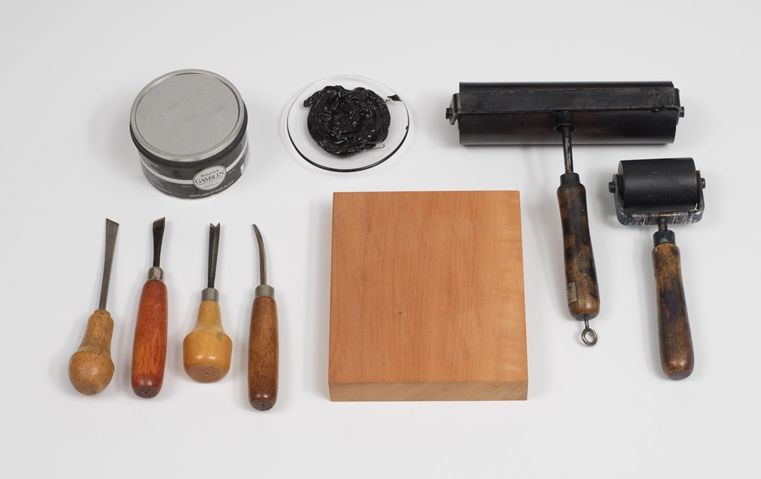List and Describe the Tools Used to Make Relief Prints.
Here the ink is applied to the raised surface. Hangit Japanese mat palette and x-acto.

Printmaking Tools Archives And Special Collections
A printing press may not be needed as the back of the paper can be rubbed or pressed by hand with a simple tool such.

. A sheet of paper is then placed on top of the block and vertically pressed against the surface. The gouge is a triangular shaped printmaking tool used to produce a rounded line. In all relief techniques it is the surface of the block that is inked and printed and given perfect printing all lines or surfaces will be equally dark.
PINE Pine is the most prevalent soft wood available for woodcutting. Block Print Black. Examples of relief-printing processes include woodcut anastatic printing also called relief etching linocut and metal cut.
Printmaking linocut metal cut anastatic printing. WOODCUT and LINOCUT are usually used for relief printing. He mixed powdered cork with linseed oil spread the emulsion onto burlap or canvas and allowed it to oxidize and harden.
Youll start to see where the ink is going to go once its printed. Pine Popular Basswood plywood Hard woods. All of the following are examples of commonly used tools in relief printing except which.
Etching and engraving are the most common types of. It reached full maturity in the 15th and 16th centuries. Add more ink if needed to get an even coat of ink.
Prints created by inscribing the image into the plate and then filling the gaps with ink are called intaglios. Apply ink to the block. Prints drawings and manuscripts Printmaking Browse this content Introduction to printmaking Introduction to relief printmaking Relief process Introduction to intaglio Intaglio process Lithography process Introduction to lithography Making and conserving manuscripts and drawings Making manuscripts Renaissance Watercolours.
Many of the supplies can also be used for Linocut printmaking if thats what you prefer as well. Another tool used is a knife. The surface of the block is inked using a dabber or a roller.
This describes prints that are made by cutting the picture into the surface of the printing plate. Below youll find a list of materials and tools that you can use to make your own Woodcut print. Using a sharp V-shaped tool called a burin the printmaker gouges the lines of an image into the surface of a smooth polished sheet of metal or in some cases a piece of plexiglass.
Relief Printing Process. To make a print ink is pushed into the lines of the design. Graves are also used for scraping out the wood.
In relief printing we are talking about a matrix which can be inked and paper pressed against it to produce an image. Both hand tools and power tools are used to cut the image to be printed. Wood Tools Paper Ink Soft woods.
Some commonly used types of knives include. Knife gouges sharpening stone brayers Rubber and composition Papers. Linoleum was a versatile craft material ideal for relief printmaking.
The most common types of relief processes are. Woodcut is one of the oldest and simplest forms of printmaking. Many experts agree that printmaking techniques can be roughly divided into four basic categories of relief intaglio planographic and stencil.
Linocuts and woodcuts are called relief prints since the ink is transferred from the area that stands out from the background. A means of making prints by creating a raised design on a flat surface usually produced by cutting away non-image material. Cover the block all the way to the edges rolling the ink back and forth gently over the block.
Linoleum Block Printing In the mid-nineteenth century Frederick Walton developed and patented linoleum in the United Kingdom as a floor covering material. The block material is cut away leaving the print image. The relief method is one of the simplest types of printmaking in which the material is carved or otherwise taken away from around the protruding design that is to be printed.
Lastly paper and ink is also used. Fruit foods other hard woods Woodcut tools. While traditional printmaking techniques include woodcut etching engraving lithography and screen printing Serigraphy.
The design is inked or covered with color and stamped on paper or another surface. Welcome to the first in a series of videos and posts on Woodcut Printmaking. Printmaking is utilized by numerous artists today.
Roller used to spread ink on a relief plate. What tool is used to roll the ink over a piece of wood after the engraving has been done. Show more relief printing in art printmaking a process consisting of cutting or etching a printing surface in such a way that all that remains of the original surface is the design to be printed.
The ink sits on the surface of the matrix and direct downwards pressure on the paper is applied using either hand-rubbing or a press to transfer the ink from the matrix to the paper. Woodblock printing originated in _____ during the 14th century. Modern techniques have extended to include spray painting encaustic and gelatin printmaking.
A woodcut is probably the oldest and simplest form of relief printmaking. Leather pads chalk and brayers. Printing performance depends on how you prepare the prototypegrid or matrix.
The image is raised above the surface of the block. Then gently roll the ink onto the block using the ink-covered roller. The non-recessed surface will leave ink on the paper whereas the recessed areas will not.
Newsprint Tableau Moriki Hosho Kochi Ink. Relief printing is a family of printing methods where a printing block plate or matrix- which has had ink applied to its non-recessed surface- is brought into contact with paper. This can be done by hand or using a printing press.

Woodcut The Metropolitan Museum Of Art

Printmaking Reference Sheet Relief Print Art Education Resources Printmaking

Pin By Jason Dorofy On Studio Art Linoleum Printmaking Printmaking Art Linocut Printmaking


Comments
Post a Comment